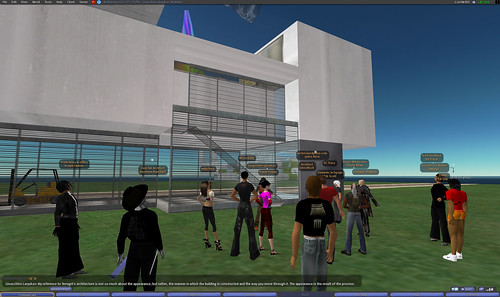Transcript of Gioacchino Laryukov’s presentation is below. Transcript of the entire discussion can be found HERE.
“Giuseppe Terragni (1904-43) was an Italian architect who worked in the ’30’s during a period when others such as Sartoris, Cattaneo, Figini, Lingeri, Pollini were active; an era known as rationalism. His best known works can be found in the city of Como, where he lived and worked during his brief life. You can find a listing of rationalist buildings in Como here: http://www.ordinearchitetticomo.it/itinerari.asp The main works are: Edificio ad appartamenti Novocomum (1927-29), Casa del Fascio di Como (1928-32), Monumento ai caduti (on a Sant’Elia drawing, 1931-33), Asilo infantile Sant’Elia (1935-37)” all of this in Como; and Casa ad appartamenti Rustici (1933-35) and Lavezzari (1934-35) in Milan.
Looking at his buildings, you can identify some aesthetic analogies with the house I have built here. I have choosen to use some of same style characteristics (like the white walls) and materials (like the glass blocks) to emphasize the reference to 1930’s architecture and in particular, the Modern Movement. My reference to Terragni’s architecture is not so much about the appearance, but rather, the manner in which the building is constructed and the way you move through it. The appearance is the result of the process. I will try to explain further:
Buildings in SL start with the prim… its finished volume. A prim could be in and of itself a house. Only you must create the internal space by emptying it. What I mean is that a room is not a space limited by four walls, a floor and a roof, but rather it is the internal space of a volume, therefore of a prim. We can also say that the walls, roof and so on, are not single elements, but are parts of that volume. You can better understand what I intended by looking at the ground floor of my house. There is a cube or rectangular box that is an emptied prim and is therefore a room. The rest is only virtual and open space defined by the grate. I want to highlight that the single elements cannot really enclose the space on their own, they don’t create a room, instead the interior of the volume can do it, likewise when two sides are opened.
The construction of the architecture is a work on volumes, and the space between those volumes. Working with some architects on the lineage of Terragni, you will often hear the term “equilibrio fra pieni e vuoti,†which is to say “balance between fullness and empty†. If you look at this house you can see three main volumes: two big cubes (10x10x10mt) to the sides, and a central cuboid that is a 10x7x5mt which is transparent at the side opposite of the stairs. Looking at the side where the stairs are located, you can see the building as a unique volume, a cube that measures 30x10mt that has been hollowed and cut to obtain the space needed. The central volume has beed reduced to create a place for the stairs, but also this is the first step towards the development of the project. I built this house working on these three volumes, not on the single walls themsleves but based on the relationship between these three elements. I have rezzed the main prims and moved them near each other. The shape, size and character of the main prims then become the foundation for the modification of another prim…. and so on, until a situation develops which I consider to be balanced. In this way, the side of the central cube, which is only 7mt, is used to create the place for the stairs, and this has determined the second level and the upper windows of the main cube. In this manner, the cube has become the structure for the internal development of the main cube. This is more evident in the other 10x10x10mt cube, which was hollowed and cut to the level of the roof of the cuboid. Also, it was divided in two different spaces by the measurements of the cuboid and this is visible in the external walls by the glass blocks.
The central message here is that the building develops based on the relationship between simple prims in a succession of steps, in which a prim dictates how you will modify the next and that one will impact the next…. and so on… Going back to Terragni: it is clear – especially in the Novocomum and in the Casa del Fascio – that his projects are, above all, a play on volumes. The Novocomum is a simple cube and the edges have been first hollowed and then that space has been occupied by cylinders. These cylinders become the foundation for the continous taper of the first floor and for the development of the balconies. The single elements like walls, balconies, roof are the volume’s children. More complex is the construction of the Casa del Fascio which is a perfect half cube (33x33x26mt). it has been partially hollowed and in this way you have other volumes, new relationships and new spaces which become the seeds for others to be developed in a succession of filling up, emptying, and cutting in spaces which are then born and take form.
The exterior appearance is the mirror; the result of the work on the volumes. This is rightfully called rationalism because all the parts of the building have a precise connection with the other parts, and all the parts of the building are elements of the procedure from which the building emanates. that’s alll what I would like to say..


